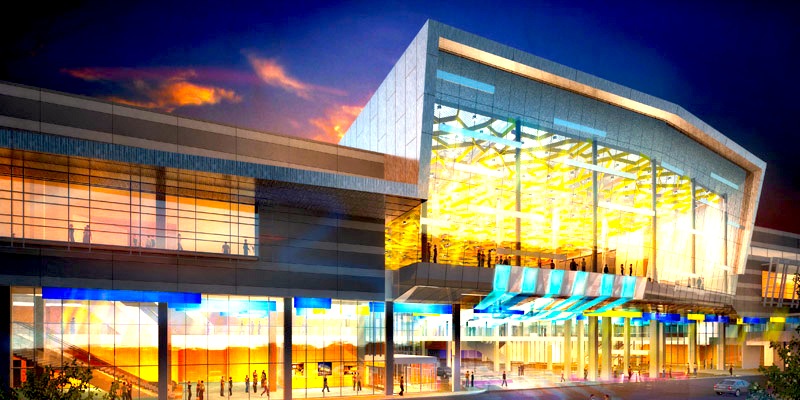February is a busy month at the Winnipeg Convention Centre. With the consumer trade show season underway, there were some eight events are listed on their calendar for the month, not including the Rotary Club luncheons held there every Wednesday.
In addition to the trade shows (the wedding show, RV show, baby show, etc.), much of what the convention centre hosts are regional industry conferences, various organization’s gala events, and the occasional kickboxing match. And of course, there’s also Mardis-Gras this weekend, when the third floor promises to be transformed “into the streets of New Orleans.”
Things slow down in the summer, and from June to August, only six events are scheduled at the convention centre so far, including Ai-Kon, “Manitoba’s premiere anime convention.”
[related_content slugs=”memories-from-skid-row-mcdinos,what-we-can-learn-from-winnipegs-walkability-score,how-to-beat-the-winter-blues” description=”More from Robert Galston” position=”right”]
It’s a little hard to believe that there are more than one anime convention in Manitoba. It’s also hard believing that the City and Provincial governments are both spending $51-million each to nearly double the size of the convention centre (the Federal government is also chipping in another $49-million). This new, 300,000 square foot addition is set to open in 2015.
Proponents of this expansion will point out that the existing Winnipeg Convention Centre, which was the jewel of the Canadian convention world when it was built in the mid-1970s, is too small and outmoded to attract many of the big trade shows and conventions anymore. Without this expansion project, it will continue to simply play host to local anime enthusiasts, brides-to-be, and drunk bros prowling an imaginary Bourbon Street.
Expand it, the thinking goes, and it will be able to bring national conventions that bring in hordes of out-of-town attendees with big company expense accounts. This will be a boon to downtown cash registers and government coffers. The economic impact will even act as a catalyst for new, private development on downtown’s many unsightly surface parking lots, the wishful thinking goes.
***
Winnipeg has not been alone in these hopes. Countless North American cities have been spooked into doubling down on their convention centre facilities in recent years, even as demand for national and regional conventions has declined since the early 1990s.
Even the busiest convention centres have felt this downward trend. Two of the busiest convention hotspots, Orlando and Las Vegas, have both seen little return on their investment in recent expansions. Chicago’s McCormick Place, the largest facility in North America, has seen the number of national conventions drop, and is increasingly finding itself booking local and regional events.
The reality is that the benefit of convention centres expansion has usually been that they are able to host multiple local events simultaneously (ie, the wedding show AND the boat show). But attendees of these kinds of events don’t inject nearly as much money into the local economy as those sought-after, drying up national conventions do.
When Winnipeg’s expansion is complete in 2015, it will be just another big, newly-expanded convention centre among scores of other big, newly-expanded convention centres across North America. What it still won’t have is a location in a city that is an air travel hub (Chicago), or has warm winter weather and an impressive list of nearby attractions (Orlando and Las Vegas).
The Winnipeg Convention Centre may also soon face a challenge to its virtual monopoly in the regional market. The Red River Exposition Association plans a 300,000 square-foot facility at the Red River Ex grounds near Headingley (to be built entirely without public money). This would be able to accommodate many of the regional trade shows currently using the downtown convention centre — with lots more free parking.
With the prospect of a crosstown rival, all of a sudden Winnipeg Convention Centre boss Klaus Lahr warns that “there is only so much need for space.”
It’s interesting how that works.
***
Even if the Winnipeg Convention Centre did see an increase in business after expansion, there are opportunity costs — an economic term that seems to be unheard of among local governments — to look at. There is the opportunity costs of the more than $150-million in public funds. Is the ability to host more RV shows the best use of this money? Should public dollars be backing the risk of the Winnipeg Convention Centre? (As it is, the City of Winnipeg spends more than $4-million a year bailing the place out.)
There’s also the opportunity costs of the land the expansion will be built on, which is currently a large parking lot owned by the Province of Manitoba. Is another massive, under-utilized box the best use of land downtown? Is this the kind of development that will help create a downtown more people are going to want to live in or visit?
To the boosters and shills, the hope of an expanded convention centre as an economic catalyst is a quixotic faith in megaprojects. For the government officials at the City Hall and the Legislature signing the cheque for this thing, it’s simple political opportunism. To them, it doesn’t matter whether or not an expanded convention centre benefits the local economy, or helps create a lasting renewal of Winnipeg’s forelorn downtown. They just want another new building to make it look like they’re transforming this old town and its old thinking into something more than a glassy Potemkin village.
___
Robert Galston likes to write about Winnipeg, urbanism, and other very, very exciting topics. Follow him on Twitter @riseandsprawl
For more, follow us on Twitter: @SpectatorTrib
